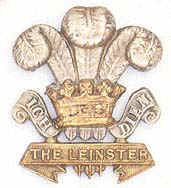The Prince of Wales's Leinster Regiment (Royal Canadians) Association
|
|
|
|

American War 1812
|
The Prince of Wales's Leinster Regiment (Royal Canadians) Association
American War 1812 |
|
History of the Prince of Wales's Leinster Regiment (Royal Canadians) The Prince Regent's County of Dublin RegimentIn the summer of 1812 (18th June) America declared war on Britain. In America at that time were the 100th Regiment together with the 8th, 41st, 49th, a small detachment of artillery, the Canadian, Newfoundland & Glengarry Fencibles and the 10th Royal Veteran Battalion. The American plan involved an attack on Ontario from each end of Lake Erie. The 100th were based in Quebec and not at all involved in the actions of 1812. In 1813 the Americans captured Lake Erie and moved upon York (Toronto) and forced the British force to abandon the River Niagara. With a stronghold at the southern end of Lake Ontario the Americans were clearly causing a problem. Detachments of the 100th, the Royal Scots, 8th Kings, the 104th, Glengarry Fencibles, Canadian Voltigeurs and the Newfoundland Regiment plus artillery totalling some 750 persons in all were assembled into a force to attack the Lake Ontario stronghold at Sackett's Harbour which was below strength due to the American's push for Toronto. The official records sent back to England report that "The advance was led by the grenadiers of the 100th with undaunted gallantry, which no obstacle could arrest" and the 100th, despite being landed in the wrong location, and facing 300 - 400 American militia advanced putting their foe to flight so permitting the remainder of the force to land and in turn push the defending force back into their stockade. To avoid the British capturing supplies and ships, the Americans set fire to their barracks and some ships when events moved in the favour of the Americans. Sir George Prevost, commanding the British attack became aware that a party of Americans were cutting off the British route back to their boats and ordered a retreat, so failing to capture the American base. Losses to the British were considered to be high at 50 killed in action with 211 casualties out of the total force of 750. The 100th lost 6 K.I.A. and 24 wounded. Now a new threat faced the 100th who were headquartered at Isle-aux-Noix an island on the Richelieu River and where two American ships appeared. Led by Major Taylor of the 100th who positioned his men either side of the river, musket fire was directed at the two American ships that turned out to be United States Ships Growler and Eagle fitted with 11 guns. The outcome was that the two ships were captured and renamed HMS Broke and HMS Shannon. Elated at this success it was decided to attack Plattburg in July 1813. A combined force of 1000 from the 13th and 100th advanced on Plattburg and destroyed the barracks, arsenal and stores. In September 1813, the 100th was transferred to the Niagara frontier with America. A major British defeat sustained on the right flank resulted in the central division retreating to Burlington Heights where the forces were regrouped to fight off the threat and maintain the Niagara frontier. Now in early November 1813 the decision was taken to mount an attack of Fort Niagara that stood opposite Fort George on the British side of the frontier. Three hundred and fifty men form the 100th together with 100 from the Royal Scots, 100 from the 2/41st 12 men of the Royal Artillery and volunteers from the Canadian militia who would go forward with ladders comprised the attack group. The defenders of Fort Niagara knew they were coming and were on maximum alert when late at night on the 18th December the British party commenced their move. The plan was to "go in" with the bayonet after crossing the river. The first party included Lieutenant Dawson and Sergeant Spearman of the 100th together with twenty Canadians. Following them were to be the grenadiers of the 100th, and the main body of five companies of the 100th. A grenadier company of the 1st Royal Scots and finally two companies of the 41st in support. Written by Don Dickson |
Send mail with questions or comments about this web site using
this form
|